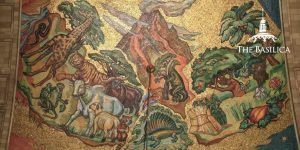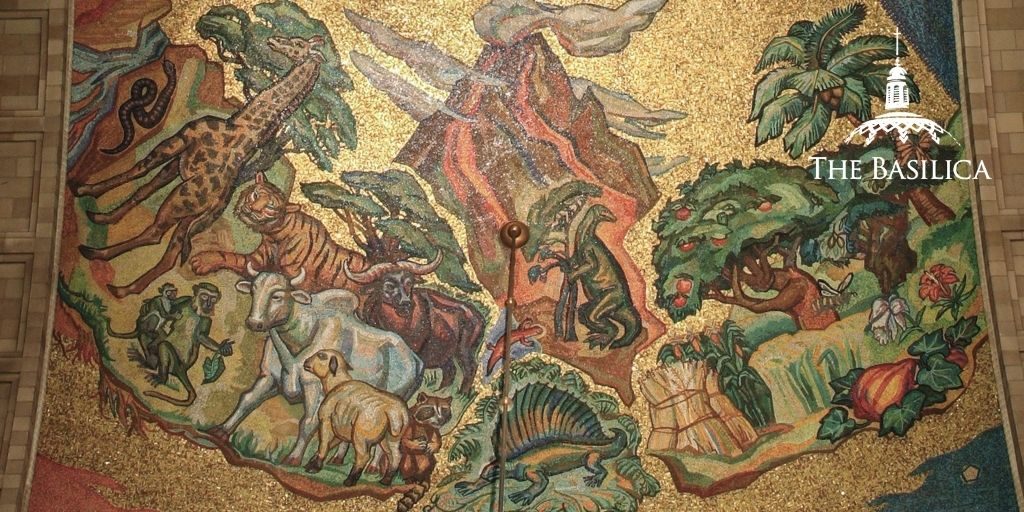
“Are not five sparrows sold for two small coins? Yet not one of them has escaped the notice of God.” – Luke 12:6
Since the creation mandate, humans have been charged by God with the care and stewardship of the earth. We know that God cares for every sparrow, and we are entrusted to care for animals as part of creation (Genesis 1:28). Throughout the Bible, and in Church tradition, animals also serve as important symbols to convey biblical truths – even representing members of the Trinity. In honor of St. Francis of Assisi, the patron saint of animals, we’re taking a look at animals as depicted in the art of the Basilica.
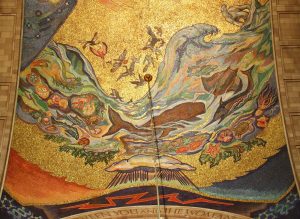
The Creation Mosaic
The Creation mosaic is the most obvious place where you can find animals in the Basilica. Artist Mary Reardon worked for three years on the piece from conception to completion, even consulting biologists and wildlife experts, to depict the days of creation. The animals portrayed include monkeys, livestock, various fish, jellyfish, birds, dinosaurs, insects, a giraffe, raccoon, tiger, polar bear, turtle, whale, and an octopus.
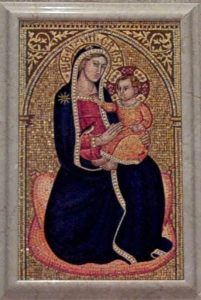
Birds in the Basilica’s Art
Birds are prevalent throughout the Basilica. On the north façade, the relief of Mary, the Immaculate Queen of the Universe, features two peacocks, which are symbols of immortality. In the Ave Maria Chapel, the north wall shows a pelican feeding her young with her own blood, symbolizing Jesus’ sacrifice, and a phoenix, whose burning to death and rising from the ashes represents the resurrection of Jesus.
The Our Lady of Grace of Montenero mosaic features a finch, bound by a cord. The cord is grasped by the Christ Child, reminding the viewer that we are in the hands of God. Simultaneously, the finch symbolizes the Passion; a legend holds that a finch snatched a thorn from Jesus’ crown while he was carrying the cross, and Christ’s blood stained the bird’s feathers.
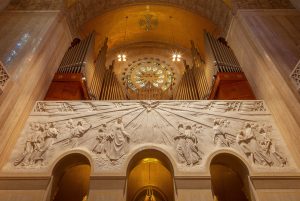
Doves can be found throughout the art of the Basilica, representing the Holy Spirit. The Universal Call to Holiness relief features a dove as the centerpiece, calling people from all walks of life. The Baldachin of the Great Upper Church contains a bronze sculpture of a dove in the center of the dome’s mosaic. The bronze doors of the Great Upper Church Sacristy feature seven doves – representing the seven gifts of the Holy Spirit: wisdom, understanding, counsel, fortitude, knowledge, piety, and fear of the Lord. In the stained glass windows of the Trinity Dome, the Holy Spirit is depicted as a dove as well.
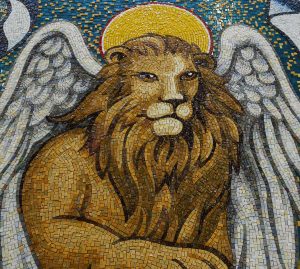
The Apostles
In the Trinity Dome, three of the apostles are depicted with an animal. Mark is paired with a winged lion; Luke, a winged ox; and John, an eagle. Matthew is not portrayed with an animal, but rather, a winged man. Called the Tetramorph, the creatures are drawn from the depiction in Ezekiel Chapter 1 and Revelation Chapter 4, where four creatures surround the throne of God. The man represents Jesus’ human nature; the lion symbolizes courage; the ox embodies sacrifice; and the eagle illustrates Jesus’ ascension and divine nature. This motif is repeated in the stained glass of the Crypt Church sacristy.
The Lamb
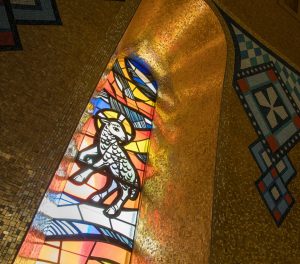
The lamb is another recurring animal in the art of the Basilica, symbolizing purity and Jesus’ sacrifice. It can be found in the Triumph of the Lamb Dome of the Great Upper Church – which features an unearthly lamb with seven eyes, seven horns, and a scroll at its feet. (The dome also repeats the pattern of man, lion, eagle, and ox, which is seen in Revelation 4 as well as Ezekiel.)
The altar in the Our Lady of Czestochowa Chapel, Trinity Dome windows, and Atonement ambulatory window of the west apse also each feature a lamb, and the Crucifixion Chapel in the Great Upper Church depicts the tie between the sacrifice of the lamb in the Old Testament, and the sacrifice of Jesus, the Lamb of God. Christ is also depicted with lambs in the Good Shepherd Chapel of the Crypt Church – showing how he also guides and directs us, his flock.
Source:
The Basilica Guidebook, ed. Dr. Geraldine Rohling

